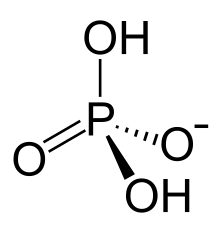Dihydrogen phosphate
Dihydrogen phosphate or dihydrogenphosphate ion is an inorganic ion with the formula [H2PO4]−. Its formula can also be written as [PO2(OH)2]−, which shows the presence of two O-H bonds. Together with hydrogen phosphate, dihydrogen phosphate occurs widely in natural systems. Their salts are used in fertilizers and in cooking.[1] Most dihydrogen phosphate salts are colorless, water soluble, and nontoxic.
 | |
| Names | |
|---|---|
| IUPAC name
Dihydrogen Phosphate | |
| Systematic IUPAC name
Phosphoric acid, ion(1-) | |
| Other names
Phosphoric acid, ion(1-)
Dehydrophosphoric acid (1-) | |
| Identifiers | |
3D model (JSmol) |
|
PubChem CID |
|
| |
| Properties | |
| [H2PO4]- | |
| Molar mass | 96.987 g/mol |
| Conjugate acid | Phosphoric Acid |
Except where otherwise noted, data are given for materials in their standard state (at 25 °C [77 °F], 100 kPa). | |
| Infobox references | |
Structure
The dihydrogen phosphate anion consists of a central phosphorus atom surrounded by 2 equivalent oxygen atoms and 2 hydroxy groups in a tetrahedral arrangement. The phosphorus atom is in the 5+ oxidation state. The dihydrogen phosphate ion carries an overall charge of −1 and it is the conjugate base of phosphoric acid.
Acid-base equilibria
Dihydrogenphosphate is an intermediate in the multistep conversion of phosphoric acid to phosphate:
| Equilibrium | Disassociation constant, pKa[2] |
|---|---|
| H3PO4 ⇌ H 2PO− 4 + H+ |
pKa1 = 2.14[lower-alpha 1] |
| H 2PO− 4 ⇌ HPO2− 4 + H+ |
pKa2 = 7.20 |
| HPO2− 4 ⇌ PO3− 4 + H+ |
pKa3 = 12.37 |
Examples
- Monocalcium phosphate (Ca(H2PO4)2)
- Ammonium dihydrogen phosphate ((NH4)(H2PO4))
Notes
- Values are at 25 °C and 0 ionic strength.
References
- Schrödter, Klaus; Bettermann, Gerhard; Staffel, Thomas; Wahl, Friedrich; Klein, Thomas; Hofmann, Thomas (2008). "Phosphoric Acid and Phosphates". Ullmann's Encyclopedia of Industrial Chemistry. Weinheim: Wiley-VCH. doi:10.1002/14356007.a19_465.pub3.
- Powell, Kipton J.; Brown, Paul L.; Byrne, Robert H.; Gajda, Tamás; Hefter, Glenn; Sjöberg, Staffan; Wanner, Hans (2005). "Chemical speciation of environmentally significant heavy metals with inorganic ligands. Part 1: The Hg2+, Cl−, OH−, CO2−
3, SO2−
4, and PO3−
4 aqueous systems". Pure Appl. Chem. 77 (4): 739–800. doi:10.1351/pac200577040739.